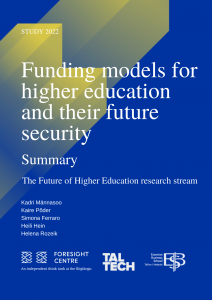Culture and sports carry national identity and maintain social memory. At the same time, they create a strong sense of belonging, boost health and support social cohesion and personal well-being. Culture and sports create economic value through job creation, tourism and exports. We cannot focus only on short-term costs and revenues in funding these sectors; it is important to take a look at their long-term impact to help build a healthier, more cohesive and more economically viable society.
Reports
The deterioration of the environment and climate warming pose significant risks to the well-being of people in Estonia. In alignment with the European Union’s green transition, Estonia has committed to achieving climate neutrality by 2050. To achieve these goals, mere improvements in existing energy systems may not suffice and fundamental changes are required in how energy is supplied to the population, and in how people move around, eat and live.
The average environmental footprint of residents of Estonia was found in 2019 to be 3.8 times the limit that the Earth can tolerate, which was higher than the average of 2.9 for residents of Europe. The environmental footprint of average household member in Estonia is bigger than that of European residents from electricity, heating, food and purchases of household appliances, while the environmental footprint from transport was smaller than the European average.
The spread of digital technology into every area of life has caused the datafication of the economy and society, as the actions of people, companies, machines and even nature leave a lasting data footprint.
Higher education has a value for individuals, the economy, and the whole of society. People are motivated to invest in higher education because they expect greater welfare in the future through higher income and the better quality of life that that allows, and also intellectual enrichment and a more varied life.
The current report focuses on the future of higher education in Estonia. The importance of human capital in the knowledge economy has promoted the debates about the role, size, and financing of higher education to the core of academic and political debates.
Mobility and the options for mobility are tightly linked with how we live our lives. We move to go to work, to study or to make use of our leisure time. The future of mobility can be seen in the broadest sense of how and where people live their lives, or more narrowly as the day-to-day mobility choices made within the existing system.
Foresight Centre developed three scenarios about the impact of the virus crises on the Estonian economy untill 2030.
Estonian regional policy has set out to implement the potential based on regional identity. So far, however, this has not been able to reverse the increasing concentration of economic activities into metropolitan regions.

 An independent think tank at the Riigikogu
An independent think tank at the Riigikogu 







